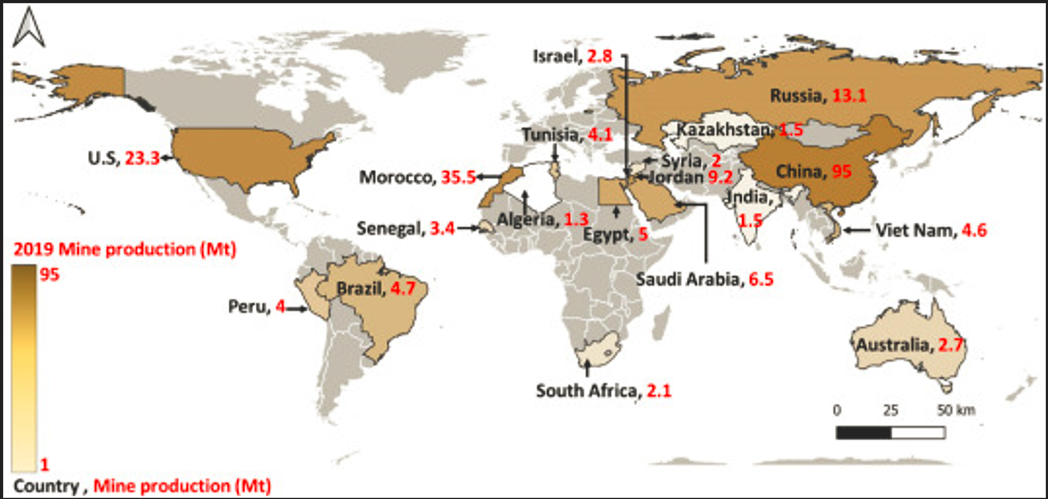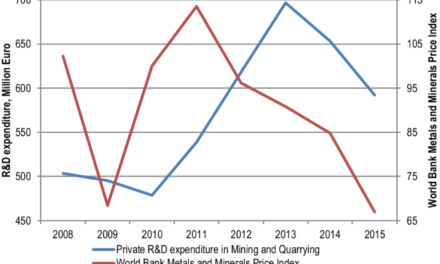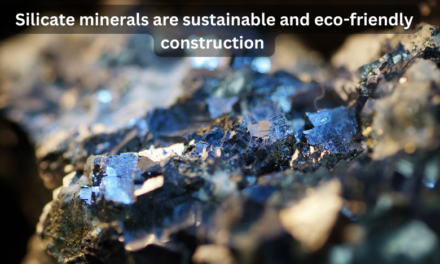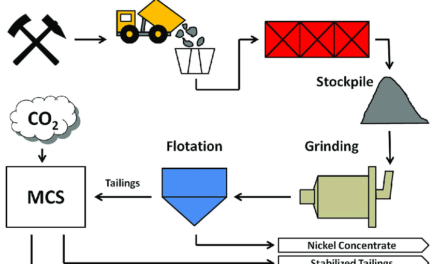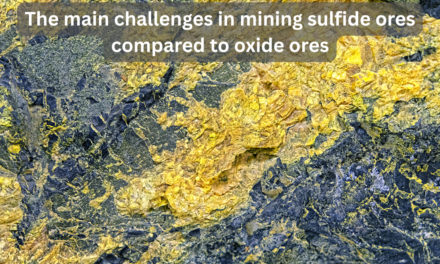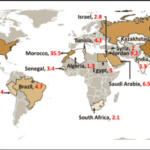Phosphate mineral deposits primarily form in sedimentary environments but can also form in igneous and metamorphic settings. These deposits are the primary sources of phosphorus, which is essential for agriculture, industry, and animal feed. The formation of phosphate deposits is a complex process influenced by geological, biological, and chemical factors. Here’s an overview of how phosphate mineral deposits form and where the largest global sources are located.
How Phosphate Mineral Deposits Form
- Sedimentary Phosphate Deposits
- Marine Sediments: The most significant phosphate deposits are typically found in marine sedimentary rocks, formed over millions of years in ancient shallow seas. Phosphorus in these deposits comes primarily from the accumulation of biogenic material (marine life, fish, and algae) and the weathering of pre-existing phosphate rocks.
- Upwelling Zones: Phosphate deposits often form in areas of oceanic upwelling, where deep, nutrient-rich waters rise to the surface, stimulating marine life such as phytoplankton and zooplankton. When these organisms die, their bodies accumulate on the sea floor, and the phosphorus in their bones and shells becomes part of the sediment.
- Biological and Chemical Processes: The accumulation of organic matter and the slow dissolution of phosphate-rich volcanic rocks contribute to the formation of phosphate minerals such as apatite. Over time, the phosphate accumulates in the sediment, forming large, phosphate-rich layers.
- Anoxic Environments: Phosphate is often concentrated in anoxic (low oxygen) environments where biological activity and the decomposition of organic matter are slowed. Such conditions are favorable for the preservation of phosphate minerals, as oxygen would otherwise cause them to oxidize and break down.
- Igneous and Metamorphic Phosphate Deposits
- Igneous Rocks: In igneous settings, phosphate minerals like apatite can form as crystallizing magma cools. This occurs in the early stages of crystallization of igneous rocks, where the phosphorus-rich fluids or melt combine with calcium to form phosphate minerals.
- Metamorphic Processes: Metamorphism of sedimentary phosphate deposits can also concentrate phosphate minerals. Heat and pressure can cause the minerals to recrystallize and form higher-quality phosphate deposits, though this process is less common than the formation of sedimentary deposits.
- Phosphorite Deposits
- The term phosphorite refers to phosphate-rich rock that is mined for its phosphorus content. These deposits can be either sedimentary or igneous in origin, but sedimentary phosphorites are by far the most important source of phosphate minerals worldwide. Phosphorites are typically formed through the processes of marine sedimentation, where phosphorus accumulates in layers of marine limestone or shale.
- Pedogenic and Residual Deposits
- In some regions, phosphate minerals may form from weathering of primary phosphate rocks. Over time, weathering processes can concentrate phosphate minerals in soil or residual deposits, leading to the formation of secondary phosphate deposits.
Largest Global Sources of Phosphate Mineral Deposits
Phosphate deposits are found around the world, but the largest and most significant sources are concentrated in specific regions. Here are the major global phosphate sources:
- Morocco and Western Sahara
- World’s Largest Source: Morocco (and the disputed territory of Western Sahara) is home to the world’s largest phosphate reserves. The Bou Craa mine in Western Sahara is one of the largest phosphate mines globally, and the phosphorite deposits in this region account for more than 70% of the world’s known reserves of phosphate rock.
- Geology: The phosphates in Morocco and Western Sahara are found in sedimentary rock layers, often concentrated in the Cretaceous period deposits, where marine phosphorite beds are widespread.
- China
- Leading Producer and Consumer: China is both a major producer and consumer of phosphate rock. The country has significant phosphate deposits in regions such as Hubei, Yunnan, and Guizhou provinces. These deposits are primarily sedimentary in origin.
- Phosphate Fertilizer Production: China uses a large portion of its phosphate for domestic fertilizer production, which is crucial for its vast agricultural sector.
- United States (Florida)
- Major Global Supplier: The Florida phosphate rock deposits in the United States are among the largest in the world, particularly in the Bone Valley region. Florida’s phosphate rock is primarily sedimentary, and the deposits are rich in fluorapatite.
- Production and Use: Florida accounts for a large portion of the U.S. domestic supply and also exports phosphate rock for fertilizer production.
- Russia
- Large Reserves: Russia is a key producer of phosphate rock, with significant deposits located in the Kola Peninsula and parts of Siberia. These deposits are primarily sedimentary and igneous in origin.
- Resource Distribution: Russia’s phosphate reserves are strategically important for both its domestic agricultural needs and its position as an exporter of phosphate-based products.
- Jordan
- Major Phosphate Exporter: Jordan is another important phosphate producer, with its phosphate reserves found in the sedimentary rock formations of the Saqi and Mazar basins.
- Economic Importance: The mining and processing of phosphate rock is a key industry in Jordan, contributing significantly to its export economy.
- Egypt
- Phosphate Mining in the Nile Basin: Egypt has large phosphate deposits along the Nile Valley and in the Eastern Desert. The deposits are mainly sedimentary in nature and are concentrated in ancient marine sediments.
- Exporting Phosphate Rock: Egypt is a major exporter of phosphate rock, which is used both domestically and abroad for fertilizer production.
- Brazil
- Increasing Global Production: Brazil has significant phosphate reserves in sedimentary and weathered deposits, especially in the state of Minas Gerais. The country has been increasing its domestic production to meet growing agricultural demands.
- Tunisia
- North Africa’s Key Supplier: Tunisia has significant phosphate reserves, particularly in the Gafsa Basin in the south. Tunisia is one of the world’s top producers of phosphate rock, which plays an essential role in both domestic agriculture and international exports.
- South Africa
- Phosphate Mining in the Western Cape: South Africa has significant phosphate deposits, particularly in the Western Cape region, where sedimentary phosphorites are common. The country produces large quantities of phosphate rock for both local use and export.
Conclusion
Phosphate mineral deposits primarily form through sedimentary processes, particularly in marine environments, where phosphorus accumulates from biological activity and chemical precipitation. The largest global sources of phosphate are located in Morocco and Western Sahara, with other major producers including China, the United States, Russia, Jordan, Egypt, Brazil, and Tunisia. These regions have abundant sedimentary phosphate deposits formed over millions of years, making them critical to the global supply of phosphorus for fertilizers, animal feed, and industrial applications. As phosphorus is a finite resource, managing these deposits sustainably is increasingly important to meet the demands of agriculture and other industries.
Hashtags
#PhosphateDeposits #PhosphateMinerals #PhosphateResources #PhosphateFormation #GlobalPhosphateSources #PhosphateMining #FertilizerRawMaterials #PhosphateRocks #PhosphateExploration #MiningRegions #PhosphateProduction #MineralDeposits #MiningGeology #GlobalMineralResources #PhosphateRichDeposits #PhosphateMiningCountries #RockPhosphate #PhosphateSupply #MineralExploration #GeologicalMinerals

